Abstract
To determine the potential role of the placenta in transmission of human immunodeficiency virus (HIV) from mother to fetus, the ability of human placental tissue to support HIV type 1 (HIV-1) infection was examined. HIV-1-seronegative first-trimester placentas were maintained in culture and infected with HIV-1. Virus production, measured by HIV-1 antigen release into the supernatant, and HIV-1 DNA, identified by polymerase chain reaction, were detected for at least 12 days postinfection. Western immunoblot analysis showed Gag proteins, precursor p55, and cleavage products p24 and p17 in HIV-1-infected tissues. Double labeling of placental villi with antibodies to CD4 and placental trophoblast-specific alkaline phosphatase indicated that trophoblasts express CD4 antigen. Additionally, immunostaining of HIV-1-infected tissues with anti-p24 antibodies demonstrated HIV-1 protein expression in placental trophoblasts. Evaluation of human chorionic gonadotropin and progesterone production by the placental cultures indicated that there was a 90% decrease in human chorionic gonadotropin and a 70% decrease in progesterone production in HIV-1-infected cultures in comparison with controls. These data demonstrate that trophoblastic cells of human placenta tissue express CD4 and are susceptible to HIV-1 infection; also, placental endocrine function is decreased by HIV-1 infection. Thus, the placenta may serve as a reservoir of HIV-1 infection during pregnancy contributing to infection of the fetus, and decreased placental hormone production may result in impaired fetal development.
Full text
PDF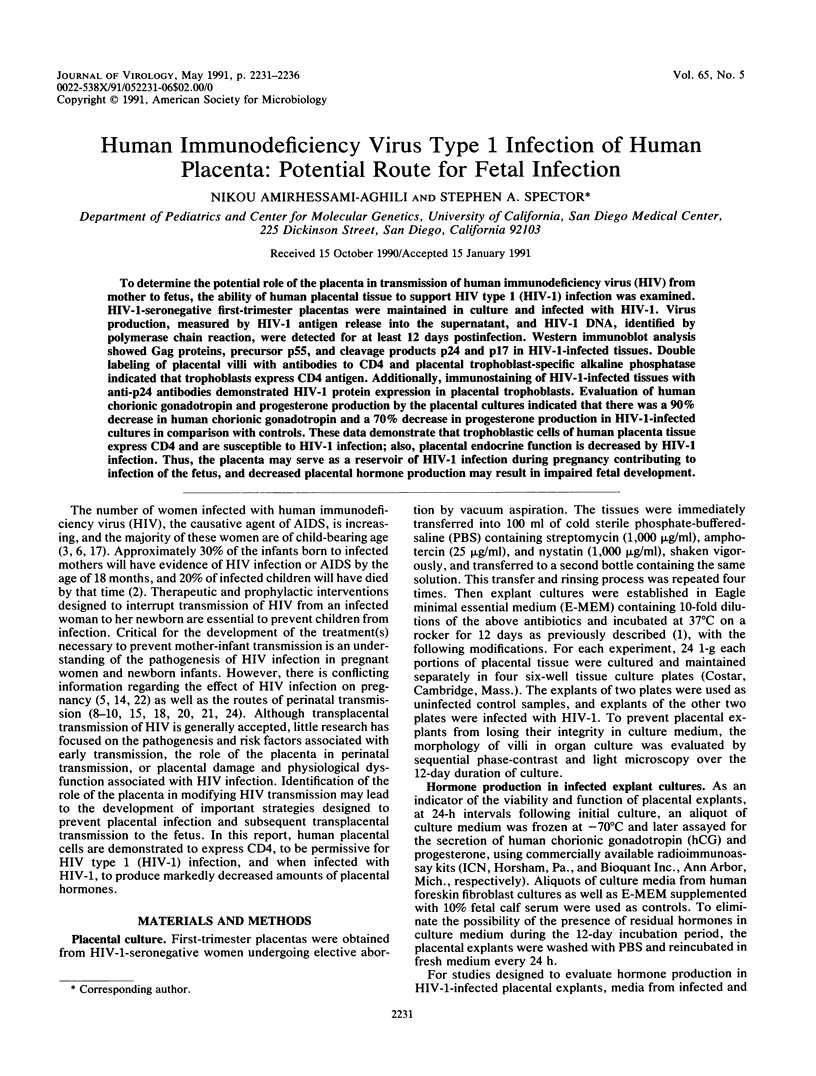
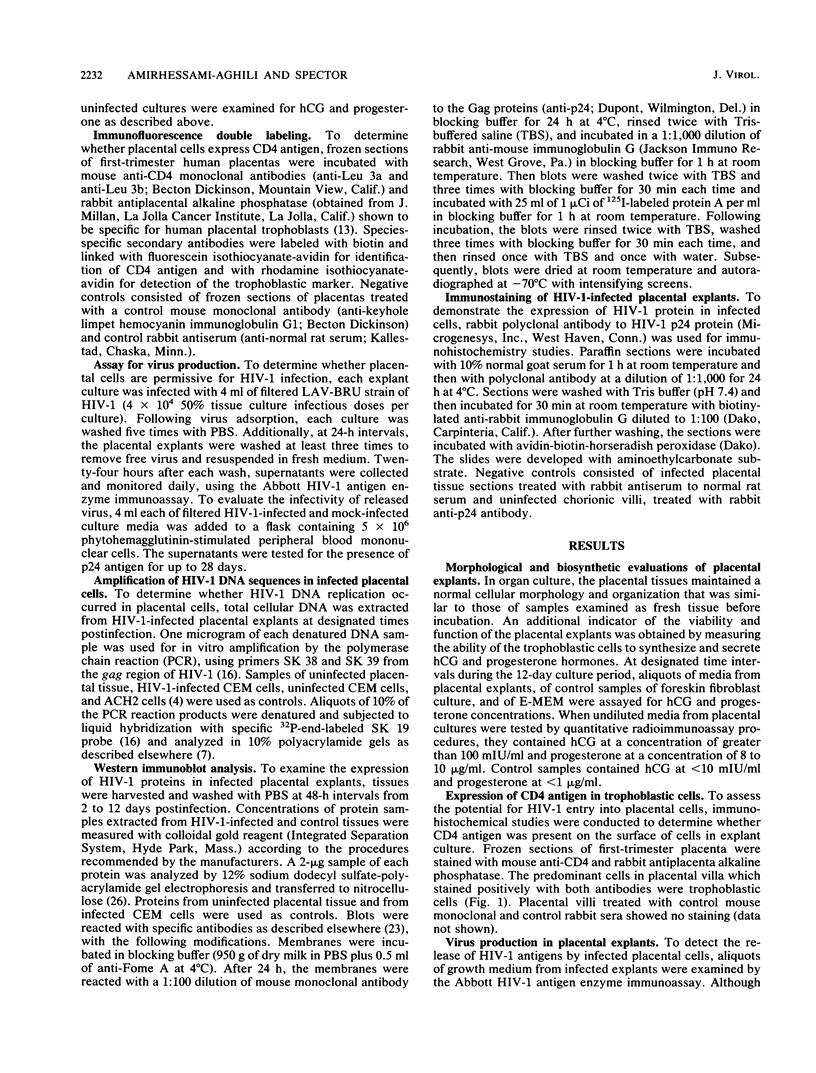
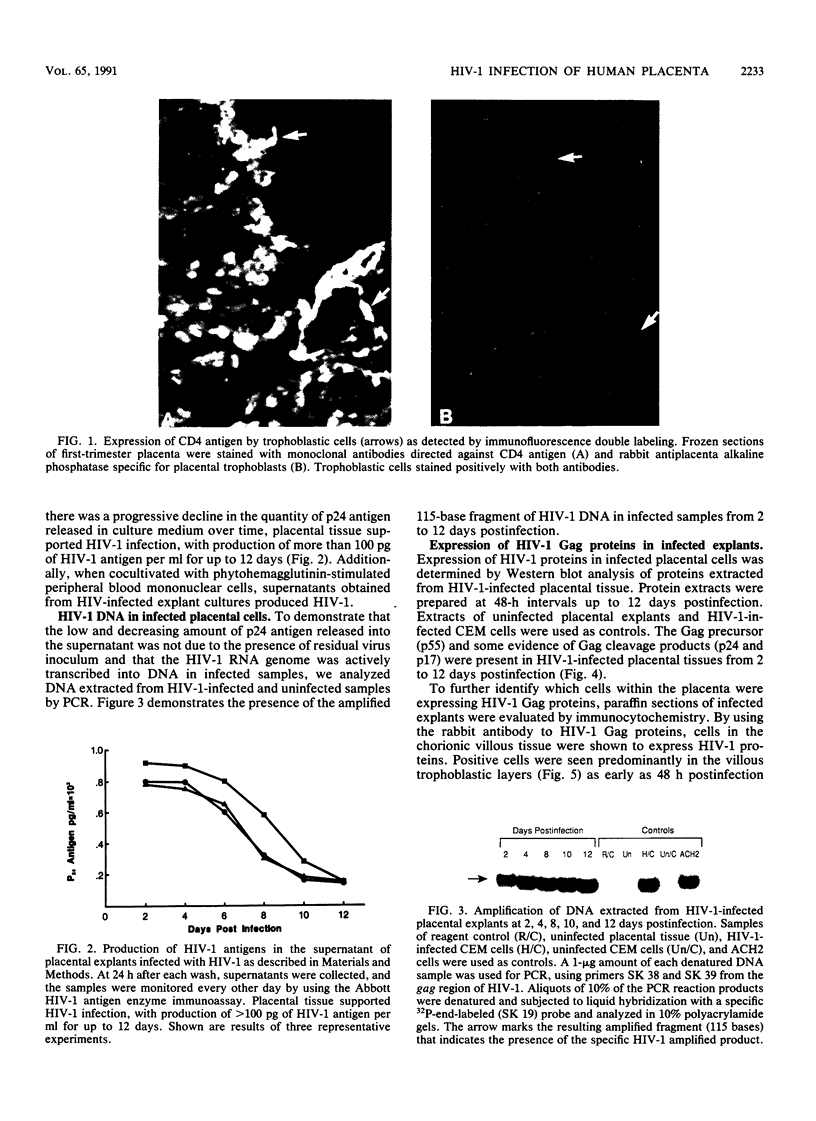
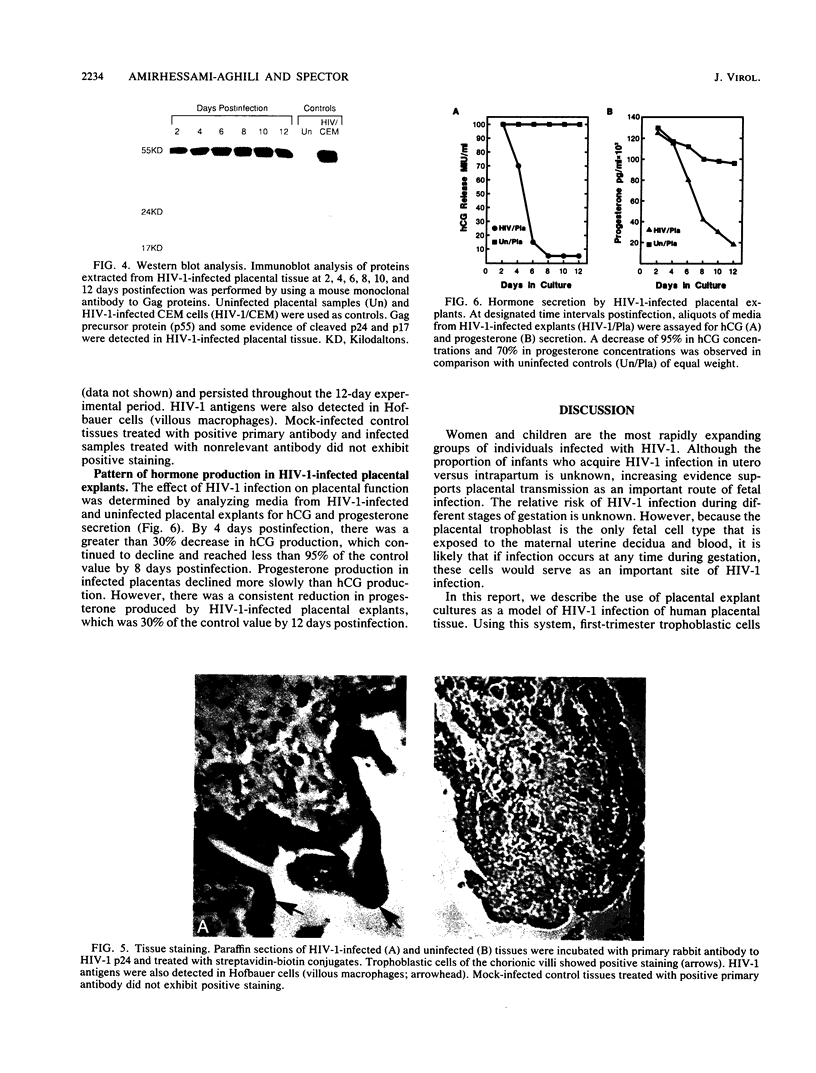

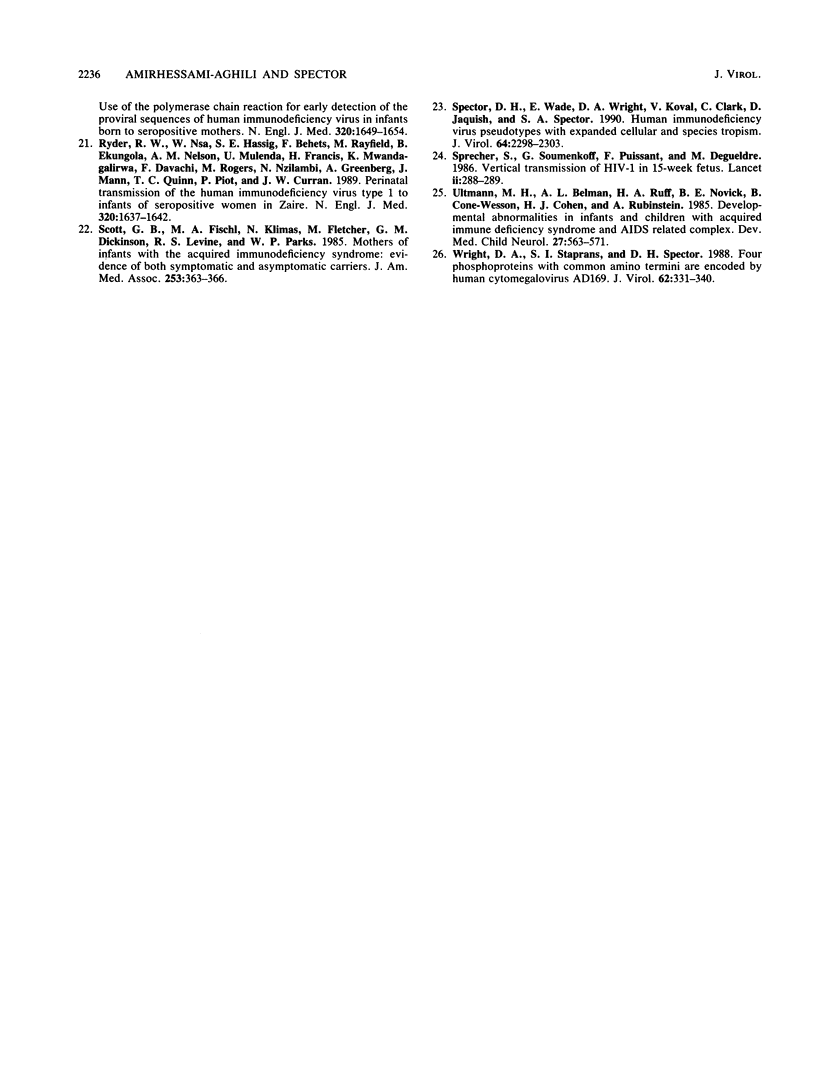
Images in this article
Selected References
These references are in PubMed. This may not be the complete list of references from this article.
- Amirhessami-Aghili N., Lahijani R., Manalo P., St Jeor S., Tibbitts F. D., Hall M. R., Afsari A. Persistence of human cytomegalovirus DNA sequences without cell-virus homology in human placental explants in culture. Int J Fertil. 1989 Nov-Dec;34(6):411–419. [PubMed] [Google Scholar]
- Blanche S., Rouzioux C., Moscato M. L., Veber F., Mayaux M. J., Jacomet C., Tricoire J., Deville A., Vial M., Firtion G. A prospective study of infants born to women seropositive for human immunodeficiency virus type 1. HIV Infection in Newborns French Collaborative Study Group. N Engl J Med. 1989 Jun 22;320(25):1643–1648. doi: 10.1056/NEJM198906223202502. [DOI] [PubMed] [Google Scholar]
- Clouse K. A., Powell D., Washington I., Poli G., Strebel K., Farrar W., Barstad P., Kovacs J., Fauci A. S., Folks T. M. Monokine regulation of human immunodeficiency virus-1 expression in a chronically infected human T cell clone. J Immunol. 1989 Jan 15;142(2):431–438. [PubMed] [Google Scholar]
- Gloeb D. J., O'Sullivan M. J., Efantis J. Human immunodeficiency virus infection in women. I. The effects of human immunodeficiency virus on pregnancy. Am J Obstet Gynecol. 1988 Sep;159(3):756–761. doi: 10.1016/s0002-9378(88)80049-8. [DOI] [PubMed] [Google Scholar]
- Hoff R., Berardi V. P., Weiblen B. J., Mahoney-Trout L., Mitchell M. L., Grady G. F. Seroprevalence of human immunodeficiency virus among childbearing women. Estimation by testing samples of blood from newborns. N Engl J Med. 1988 Mar 3;318(9):525–530. doi: 10.1056/NEJM198803033180901. [DOI] [PubMed] [Google Scholar]
- Jovaisas E., Koch M. A., Schäfer A., Stauber M., Löwenthal D. LAV/HTLV-III in 20-week fetus. Lancet. 1985 Nov 16;2(8464):1129–1129. doi: 10.1016/s0140-6736(85)90720-2. [DOI] [PubMed] [Google Scholar]
- Lewis S. H., Reynolds-Kohler C., Fox H. E., Nelson J. A. HIV-1 in trophoblastic and villous Hofbauer cells, and haematological precursors in eight-week fetuses. Lancet. 1990 Mar 10;335(8689):565–568. doi: 10.1016/0140-6736(90)90349-a. [DOI] [PubMed] [Google Scholar]
- Luzi G., Ensoli B., Turbessi G., Scarpati B., Aiuti F. Transmission of HTLV-III infection by heterosexual contact. Lancet. 1985 Nov 2;2(8462):1018–1018. doi: 10.1016/s0140-6736(85)90572-0. [DOI] [PubMed] [Google Scholar]
- Marion R. W., Wiznia A. A., Hutcheon R. G., Rubinstein A. Fetal AIDS syndrome score. Correlation between severity of dysmorphism and age at diagnosis of immunodeficiency. Am J Dis Child. 1987 Apr;141(4):429–431. doi: 10.1001/archpedi.1987.04460040087022. [DOI] [PubMed] [Google Scholar]
- Maury W., Potts B. J., Rabson A. B. HIV-1 infection of first-trimester and term human placental tissue: a possible mode of maternal-fetal transmission. J Infect Dis. 1989 Oct;160(4):583–588. doi: 10.1093/infdis/160.4.583. [DOI] [PubMed] [Google Scholar]
- Millán J. L., Stigbrand T. "Sandwich" enzyme immunoassay for placental alkaline phosphatase. Clin Chem. 1981 Dec;27(12):2014–2018. [PubMed] [Google Scholar]
- Minkoff H., Nanda D., Menez R., Fikrig S. Pregnancies resulting in infants with acquired immunodeficiency syndrome or AIDS-related complex: follow-up of mothers, children, and subsequently born siblings. Obstet Gynecol. 1987 Mar;69(3 Pt 1):288–291. [PubMed] [Google Scholar]
- Mok J. Q., Giaquinto C., De Rossi A., Grosch-Wörner I., Ades A. E., Peckham C. S. Infants born to mothers seropositive for human immunodeficiency virus. Preliminary findings from a multicentre European study. Lancet. 1987 May 23;1(8543):1164–1168. doi: 10.1016/s0140-6736(87)92142-8. [DOI] [PubMed] [Google Scholar]
- Ou C. Y., Kwok S., Mitchell S. W., Mack D. H., Sninsky J. J., Krebs J. W., Feorino P., Warfield D., Schochetman G. DNA amplification for direct detection of HIV-1 in DNA of peripheral blood mononuclear cells. Science. 1988 Jan 15;239(4837):295–297. doi: 10.1126/science.3336784. [DOI] [PubMed] [Google Scholar]
- Pyun K. H., Ochs H. D., Dufford M. T., Wedgwood R. J. Perinatal infection with human immunodeficiency virus. Specific antibody responses by the neonate. N Engl J Med. 1987 Sep 3;317(10):611–614. doi: 10.1056/NEJM198709033171006. [DOI] [PubMed] [Google Scholar]
- Qazi Q. H., Sheikh T. M., Fikrig S., Menikoff H. Lack of evidence for craniofacial dysmorphism in perinatal human immunodeficiency virus infection. J Pediatr. 1988 Jan;112(1):7–11. doi: 10.1016/s0022-3476(88)80110-0. [DOI] [PubMed] [Google Scholar]
- Ryder R. W., Nsa W., Hassig S. E., Behets F., Rayfield M., Ekungola B., Nelson A. M., Mulenda U., Francis H., Mwandagalirwa K. Perinatal transmission of the human immunodeficiency virus type 1 to infants of seropositive women in Zaire. N Engl J Med. 1989 Jun 22;320(25):1637–1642. doi: 10.1056/NEJM198906223202501. [DOI] [PubMed] [Google Scholar]
- Scott G. B., Fischl M. A., Klimas N., Fletcher M. A., Dickinson G. M., Levine R. S., Parks W. P. Mothers of infants with the acquired immunodeficiency syndrome. Evidence for both symptomatic and asymptomatic carriers. JAMA. 1985 Jan 18;253(3):363–366. [PubMed] [Google Scholar]
- Spector D. H., Wade E., Wright D. A., Koval V., Clark C., Jaquish D., Spector S. A. Human immunodeficiency virus pseudotypes with expanded cellular and species tropism. J Virol. 1990 May;64(5):2298–2308. doi: 10.1128/jvi.64.5.2298-2308.1990. [DOI] [PMC free article] [PubMed] [Google Scholar]
- Sprecher S., Soumenkoff G., Puissant F., Degueldre M. Vertical transmission of HIV in 15-week fetus. Lancet. 1986 Aug 2;2(8501):288–289. doi: 10.1016/s0140-6736(86)92110-0. [DOI] [PubMed] [Google Scholar]
- Ultmann M. H., Belman A. L., Ruff H. A., Novick B. E., Cone-Wesson B., Cohen H. J., Rubinstein A. Developmental abnormalities in infants and children with acquired immune deficiency syndrome (AIDS) and AIDS-related complex. Dev Med Child Neurol. 1985 Oct;27(5):563–571. doi: 10.1111/j.1469-8749.1985.tb14127.x. [DOI] [PubMed] [Google Scholar]
- Wright D. A., Staprans S. I., Spector D. H. Four phosphoproteins with common amino termini are encoded by human cytomegalovirus AD169. J Virol. 1988 Jan;62(1):331–340. doi: 10.1128/jvi.62.1.331-340.1988. [DOI] [PMC free article] [PubMed] [Google Scholar]






